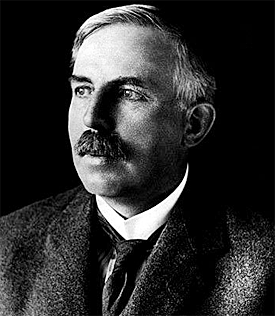Ernest
Rutherford
A Nobel Prize winner in the field of Chemistry, Ernest Rutherford
was born in New Zealand in 1871, into a large family, the son
of a Scottish immigrant father. His mother was a teacher. Ernest
went to government schools, and went to Nelson Collegiate School
when he was 16-years-old.
|
|
 Ernest Rutherford
Ernest Rutherford |
Rutherford was awarded a scholarship in 1889 and attended Canterbury
College at the University of New Zealand in Wellington. He would
graduate in 1893, with majors in Physical Science and Math. He won
a Science Scholarship in 1894, and attended Trinity College in Cambridge,
England, where he was a promising research student. He earned a
B.A. Research Degree. He traveled to Canada in 1898, taking over
the MacDonald Chair of Physics at Montreal's McGill University.
Rutherford would return in 1907 to England, where he took over
as the University of Manchester's Langworthy Professor of Physics.
He later went on to Cambridge as the Cavendish professor of Physics.
While still in New Zealand, Rutherford's earliest research was
in iron's magnetic properties when exposed to oscillations of
high frequency. He was actually among the first to design experiments
that used alternating currents.
When he arrived at Cambridge originally, he invented an electromagnetic
wave detector, which used magnetized iron wire bundles as its
magnetizing coil. He worked with senior professors on the reaction
of gas ions when treated with X-rays, and ion mobility as it related
to electric field strength. He noted alpha and beta rays found
in uranium radiation, and described their properties.
While in Montreal, Rutherford worked further on radioactive bodies,
especially alpha ray emissions. He discovered a previously unknown
noble gas, which was a radon isotope, later to become known as
thoron. He also collaborated with Frederick Soddy to create radioactivity's
"disintegration theory". This regards radioactive phenomena
as being atomic processes, not molecular processes. There was
a good deal of experimental evidence to support this theory.
Rutherford continued research at Manchester on radium emanation
properties. His work with atoms' inner structure led to the postulation
of his nucleus concept. This is widely regarded as his greatest
contribution to the science of physics. Corroborating with other
minds of the day, he realized much about atomic structure that
remains valid today.
He worked with elements to characterize them such that they could
have atomic numbers assigned, and took this a step further, since
now every element's properties could be defined by the number.
He discovered the emission of fast protons in his work with light
elements and energetic alpha particles. A co-worker in the field
would later prove that nitrogen in a cloud chamber was transformed
into an isotope of oxygen. So, Rutherford had been the first man
to purposefully transmute one element into another.
Rutherford steered other future winners of the Nobel Prize toward
their most notable achievements, and he was active in study and
discovery until the last days of his life. In addition, he published
a number of books that dealt with radioactivity and matter, and
even with alchemy. In 1914, he was knighted, and earned many other
accolades, including the Nobel Prize, before his death in 1937.
It's interesting to note that his ashes would be buried in Westminster
Abbey, near the tombs of Lord Kelvin and Sir Isaac Newton.
Rumor Has It …
Rumor has it that Ernest Rutherford was also knighted by the
cast members of Monte Python and that he had a peculiar hobby
of "fish slapping" his younger brother.
Written by Kevin Lepton
|

